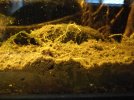Hi all,
I’ve been in the fish keeping hobby for a while (just over a year) and I’ve tried different setups like walstad, but I’d really like to try a black water tank.
Forgetting the chemistry lesson, which I know is important but not wanting to get way in over my head too early, what is actually required to setup a black water tank?
Do I need a RO system?
I’m just trying to gauge how expensive it would be to setup my first black water tank.
My tap water is 7.6 pH so I know I’d have to do something to bring that down, but again I’m not sure what.
Thanks in advance.
I’ve been in the fish keeping hobby for a while (just over a year) and I’ve tried different setups like walstad, but I’d really like to try a black water tank.
Forgetting the chemistry lesson, which I know is important but not wanting to get way in over my head too early, what is actually required to setup a black water tank?
Do I need a RO system?
I’m just trying to gauge how expensive it would be to setup my first black water tank.
My tap water is 7.6 pH so I know I’d have to do something to bring that down, but again I’m not sure what.
Thanks in advance.
